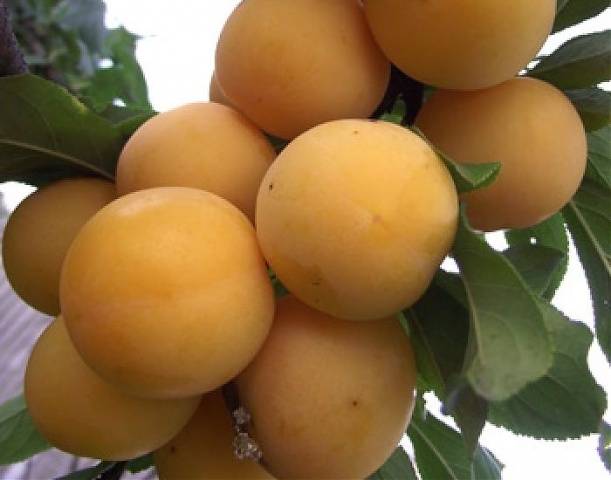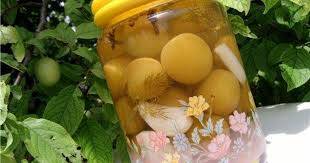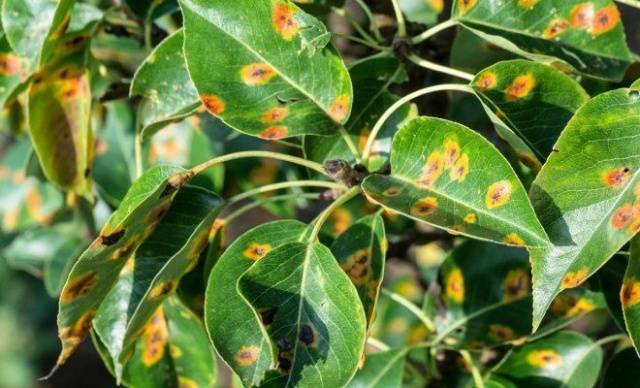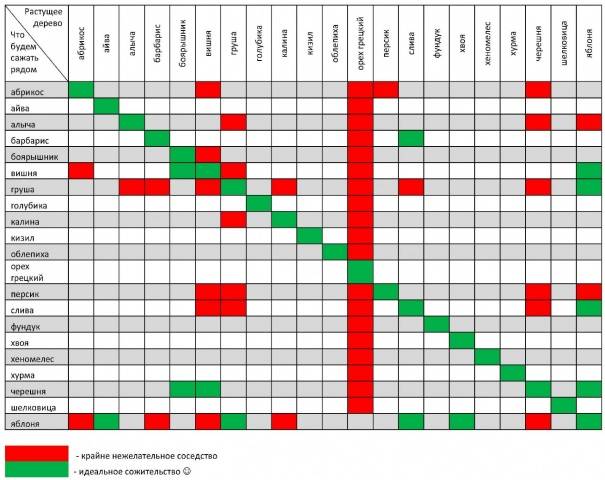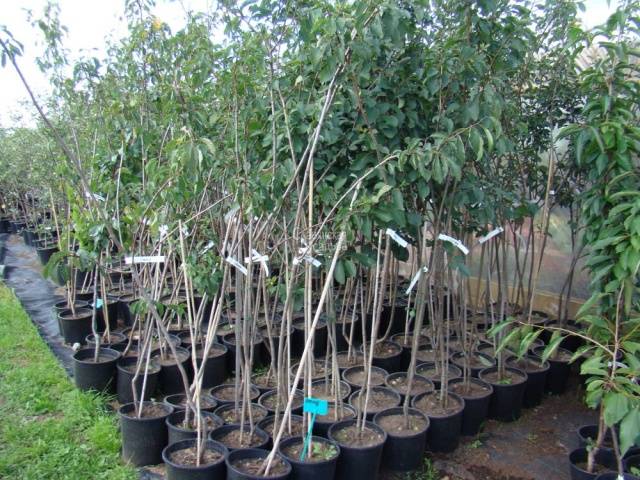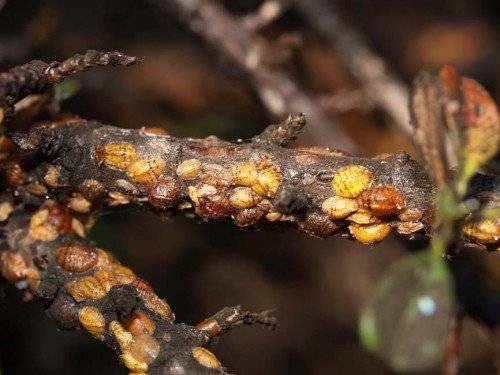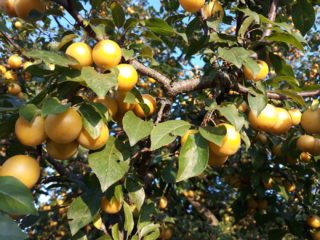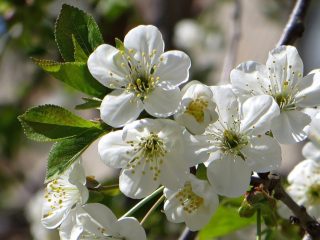Content
Cherry plum cultivars, including Tsarskaya cherry plum, are used as a fruit crop. Often used as a fresh seasoning, it is an ingredient in Tkemali sauce. The tree during the flowering period is very beautiful and gives the garden an elegant look.
Breeding history
Hybrid cherry plum "Tsarskaya" bred by breeders of the Moscow Agricultural Academy named after K.A. Timiryazeva by free pollination from the "Kuban Kometa" variety. The Russian plum appeared in the 20th century, as a result of the crossing of cherry plum and Chinese plum. Later, the "Kuban comet" variety was bred.
Description of culture
When describing the Tsarskaya cherry plum variety, everyone notes that the tree is undersized and has a height of 2.5 m. The crown is sparse, compact, round and slightly flat. The foliage is light green, elongated with pointed ends. "Tsarskaya" plum has round fruits, with an average weight of 18 to 25 g. It tastes sweet and sour, the heart is juicy and bright yellow. The fruits of cherry plum (plum) "Tsarskoy" have a small waxy bloom, their peel is dense. The value lies in the rich taste characteristics of the fruit and the possibility of long-term storage of the fruit (up to 1 month). The tree is distinguished by an abundance of fruits and early maturity. Already in the second year, you can get the first harvest. Cherry plum "Tsarskaya" is resistant to frost and diseases. During flowering, beautiful white flowers with smooth petals bloom. Plum prefers well-lit areas and fertile soil with low groundwater levels. It is recommended to plant pollinating trees nearby for Tsarskaya cherry plum at a distance of up to 15 m. With this approach, the plum will bring a large harvest every summer.
Characteristics
Among the important characteristics of the “Tsarskaya” cherry plum variety, there is a high content of citric acid and sugar in the fruits. Cherry plum contains a lot of vitamins and minerals. This variety of plum is able to remove cholesterol, is a good diuretic, which helps to remove salts and harmful water from the body, support the work of the heart and prevent heart, liver, and kidney pathologies. Plum can improve appetite, rid the body of excess bile, it eliminates constipation and intestinal atony. Yellow cherry plum "Tsarskaya" is well absorbed by the body and is even able to lower the temperature. Ripe plum is rather sweet, sourness indicates the immaturity of the fruit.
Drought resistance, winter hardiness
The Tsarskoy cherry plum tree itself and its crown have good frost resistance, they are able to withstand temperatures up to - 350C. At the same time, the root system will not tolerate severe frosts or a significant decrease in temperature, they can freeze already at - 100C. In the presence of snow, it should be raked up to the cherry-plum trunk, and in the absence of such, it is imperative to protect the root system of the tree from freezing. Mulching the soil up to 7 cm with horse manure will protect the roots, you can use leaf litter or spruce branches. It is better to wrap the tree stump with nylon. Growing cherry plum "Tsarskaya" will not bring much trouble.
Pollination, flowering period and ripening times
Plum "Tsarskaya" - requires help in pollination, and therefore it is necessary to plant pollinator trees from 3 to 15 m from it, the following varieties are perfect for this:
- cherry plum "Kuban comet";
- cherry plum "Found";
- cherry plum "Cleopatra";
- cherry plum "Traveler";
- cherry plum "Pramen".
The plum begins to bloom from the end of April, and already at the beginning of August we collect ripe fruits.
Productivity, fruiting
The yield of "Tsarskoy" cherry plum is good and reaches 25 kg per tree. Fruits are medium, about 20 g, ripening in late July - early August. The tree begins to bear fruit from the second year after planting.
Scope of the fruit
You can use the "Tsar" plum fresh and dried, compotes and juices are prepared from the fruits of this variety. When processing plums, jams, wine are made from it, and used in baked goods.
Disease and pest resistance
This plum variety is resistant to many common diseases and pests, but for a consistently high yield, a number of measures and preventive measures should be taken. For different varieties of plums, the following diseases can be dangerous:
- moniliosis can damage the trunk, leaves and branches;
- rust affects the leaves;
- powdery mildew affects leaves, shoots and trunks;
- swamp will damage the wood of branches and trunks;
- the downy silkworm will hit the foliage of the tree;
- the moth will strike the fruits, which will significantly reduce the yield.
It is necessary to constantly monitor the absence of diseases in the tree, with the first signs of the disease, it is necessary to immediately start the fight, treat it with special means and preparations. In the photo of the Tsarskaya cherry plum, we can see the leaves damaged by rust.
Advantages and disadvantages
Among the advantages of the yellow cherry plum "Tsarskoy" are:
- early maturity;
- consistently good harvest;
- resistance to diseases and pests;
- storage duration and the ability to easily carry transportation;
- the beauty of the fruit.
Despite such a number of positive qualities, this variety also has some disadvantages:
- self-infertility;
- tendency to overgrowth;
- low resistance of roots to frost.
Despite this, the reviews about the Tsarskaya cherry plum variety are the most positive.
Landing features
Among the peculiarities of planting and caring for the Tsarskaya cherry plum, there is a demand for the land; it is necessary to add ash or manure to it when the soil is acidic. You should also adhere to some rules when planting a seedling.
Recommended timing
The best period for planting a sapling "Tsarskoy" plum is March-April. This must be done before the kidneys swell. Land for planting should be prepared in a few weeks and pre-cleared of weeds.
Choosing the right place
The best soil for plums will be loamy drained soil, preferably the absence of subsoil waters, the distance to the place of their flow to withstand more than 1.5 meters. Plum loves good lighting and protection from cold winds. The ideal place for planting is considered to be the southern or southwestern section near the walls of the house.
What crops can and cannot be planted next to cherry plum
Any kind of plum can be planted next to cherry plum, at a distance of 3 meters. Moreover, the variety "Tsarskoy" plum is self-fertile. Cherry plum will be dissatisfied with the neighborhood with pear, walnut, cherry and apple, the exception may be an old apple tree. She treats the rest of the trees quite calmly.
Selection and preparation of planting material
When choosing a cherry plum seedling, you need to carefully examine the condition of the roots, they must be strong, elastic, developed, whole and fresh. The root system should contain up to 6 shoots, each about 25 cm long.
The ideal option is a two-year-old seedling obtained by cuttings or overgrowth. Such a tree will have the ability to recover better after freezing.
Landing algorithm
For good growth of a cherry plum seedling, the following rules should be considered:
- the distance between trees is more than 3 m;
- a pit with a diameter of 60 cm and a depth of 80 cm;
- the obligatory addition of a mixture of horse manure (or humus) with potassium sulfate and superphosphate;
- the presence of drainage from broken brick or crushed stone;
- the roots, immediately before planting, must be dipped in a mixture of clay and water, which should be the consistency of sour cream;
- in the pit, the roots are gently straightened and sprinkled with good fertile soil;
- the root collar should be 7 cm above the soil level;
- after planting, pour into the recess at a distance of 50 cm along the near-trunk circle, use at least 3 buckets of water;
- be sure to mulch the seedling with peat or compost with the addition of dolomite flour or garden lime, the layer should be up to 8 cm.
Follow-up care of the culture
For a beautiful crown formation, it is necessary to cut off all tree branches by 1/3 when planting. The most favorable time for pruning the Tsarskoy cherry plum is the beginning of April. In the first years of tree growth, you need to cut off all branches, leaving only the strongest skeletal branches at the base. It is imperative to cut off the shoots. After 4 years, the central conductor should be removed, then the crown will get the most correct shape. Cut off shoots over 50 cm in spring. Branches that bend strongly under the weight of the fruit should also be pruned.
When preparing for wintering cherry plum "Tsarskaya", pay special attention to the roots of the tree. The stem of the tree must be wrapped in breathable material, and the roots must be covered with a 7 cm layer of horse manure.
Plum loves moisture and regular watering is simply necessary for it. During the growing season, watering should be carried out at least 1 time in 10 days. One tree should consume at least 5 buckets of water. After watering, the soil near the tree should be loosened and weeded.
In the fall, you need to feed the tree: 6 kg of humus are mixed with 60 g of urea per 1 sq. m. Alych should be fed three times during the growing season:
- March - 40 g of potassium and urea sulfate;
- early June - 40 g of urea and nitrophic;
- end of August - 40 g of superphosphate and potassium sulfate.
In winter, nylon will help protect against rodents, which should be wrapped around the trunk.
Diseases and pests, methods of control and prevention
To protect against aphids, you need to spray the tree with a 1% solution of DNSC or laundry soap diluted in an amount of 200 g per 10 liters of water. The brown fruit mite is afraid of 10% Karbofos (75 g per 10 l of water) or 10% benzophosphate (60 g per 10 l of water). Spraying with 0.2% Metaphos or 0.3% Karbofos will protect from the plum moth, installing trapping belts made of cardboard or burlap up to 25 cm wide will help, they must be tied to the trunk.
To protect against powdery mildew, sore areas should be removed and treated with a solution of copper sulfate. As a preventive measure, treatment in April with a solution of colloidal sulfur (20 g) with the addition of copper sulfate (5 g) to a bucket of water will help. Spraying 1% Bordeaux liquid in a proportion of 100 g per bucket of water helps to get rid of rust. Moniliosis can only be removed by completely cutting the infected area of the tree with 10 cm of the healthy part. Copper sulfate is used as a preventive measure. It must be diluted in a proportion of 100 g per bucket of water and sprayed on the tree.
Conclusion
Cherry plum variety "Tsarskaya" is the most productive, its fruits have excellent taste and bright color. It contains a large amount of vitamins and nutrients. This tree will certainly become a decoration of any garden, and the plum will delight its owners with a consistently good harvest.
Testimonials
Reviews of cherry plum "Tsarskaya" are the most positive. Here is some of them:
